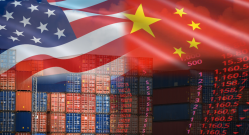
World – Macro-economic Scenario 2022-2023 –Horizon gloomy... but above all uncertain
Inflation has left its mark on the entire scenario: the same applies to monetary tightening. A number of variables – energy constraints imposed by the war in Ukraine, the expected rate of deceleration of inflation, the severity of the sting imposed by monetary tightening – impact economies’ path towards a significant slowdown or even recession.
Our economic scenario is still based on an unfortunate but still valid premise, one not radically altered by the Ukrainian counter-offensive, that that the war between Russia and Ukraine will remain intense and that the peace process will be distant. Externally, the Russian leadership is increasingly isolated diplomatically and has seen its reputation tarnished; internally, it has been weakened by the rupture of the social contract introduced by the partial mobilisation. But Russia has not collapsed economically.
Inflation – whether due to over-stimulated demand (in the US in particular) or supply constrained by shortages of inputs and then that of energy products (Europe in particular) – has left its mark on the entire scenario: the same applies to monetary tightening. A number of variables – energy constraints imposed by the war in Ukraine, the expected rate of deceleration of inflation, the severity of the sting imposed by monetary tightening – impact economies’ path towards a significant slowdown or even recession. A slight shift in assumption is enough to singularly modify the outlines of the inflation and growth scenario: from hopes of a little less US inflation pointing to a soft landing, to the risk of a proven gas shortage in Europe causing a more severe recession. However, the imbalances inherited from the pandemic, essentially in the form of still abundant household savings and a still robust labour market, paradoxically provide shock absorbers: if they do not allow us to escape recession, they provide hope that the extent of the recession remains limited.
In the US, after two quarters of contraction in GDP, not enough to officially be classified as a recession, the momentum seems to be enough to return to positive but modest growth in H222. Annual growth therefore looks set to slow from 5.7% in 2021 to 1.7% in 2022. Signs of a slowdown are starting to emerge, whether discreet (labour market) or obvious (residential investment). Initially forecast for H223, the downturn is likely to be earlier and a little more pronounced, leading to a slight recession and growth of only 0.5% for the whole year. The dampening of consumption and the improvement in supply chains suggest a significant but still-distant decline in inflation (from Q323). However, the Fed has made the decline in inflation a priority, considering it preferable to briefly endure a recession than to suffer the negative consequence of too-high inflation on a long-term basis. It is therefore unlikely that the Fed will shift its position in 2023, even in the case of a slight recession; just as it is futile to rely on any fiscal support.
In Eurozone, Our central scenario is based on the assumption that efforts to diversify gas supplies and the voluntary reduction in consumption will help avoid ‘imposed’ rationing.
After being buoyed in H1 by the post-omicron rebound and by public measures to mitigate rising prices, since summer the Eurozone has experienced (1) suddenly much more limited supply of Russian gas; (2) accelerating inflation; and (3) tightening financial conditions. Our central scenario is based on the assumption that efforts to diversify gas supplies and the voluntary reduction in consumption will help avoid ‘imposed’ rationing. However, it assumes a decline in GDP in Q422 that looks set to continue in Q123: weakening demand, operational constraints affecting companies (more limited energy supply, increasing costs, less accommodative financial conditions) and erosion of profitability. Thanks to a comfortable overhang, growth could exceed 3% in 2022 but only be slightly positive in 2023 (0.4%): a soft landing… A very relative soft landing that conceals the extent of the deceleration and GDP growth exceeding 5% at the beginning of 2022 before becoming slightly negative in mid-2023. Despite a higher gas price, this scenario assumes a decline in average inflation in 2023 (to 6.7%, after 8.3% in 2022): inflation reduces demand and eventually eases price pressures. However, weakening activity in order to stifle inflationary pressures on non-energy goods and services is also the aim of the ECB. Finally, the outlines of a harder landing scenario in 2023 are easy to trace: we only slightly shift the energy assumptions: inflation remains high and GDP declines by 0.6%.
In terms of the emerging constellation, the obstacles (inflation, local and global monetary tightening, slowdown in external demand, fiscal room for manoeuvre exhausted, geopolitical risks) do not have the same dimension depending on the country, but they are emerging and impacting growth. In China, in particular, the zero-Covid policy, the slowdown in the property sector, the forecast brake on exports suggest mediocre performances. And imbalances (excessive internal debt), the consequences of which are feared in the medium term, are ultimately materialising and hampering the response of China’s policymakers, who are reticent to adopt large-scale stimulus plans.
Monetary tightening has taken a more aggressive turn. Higher, more widespread, more durable: inflation is resilient. And reducing inflation is currently major central banks’ single priority at the possible expense of growth: It is difficult to see central banks easing prematurely in 2023. Our scenario assumes a Fed funds rate at 4.00% at end-2022, a forecast surrounded by upside risks, then at 4.25%, a ’high plateau’ reached Q123. Recently converted to tightening, the ECB is expected to continue to increase rates at least until the beginning of 2023, thereby taking the deposit rate to 2% at end-2022, in line with estimates of a neutral rate, and then to 2.25% in February. The priority given to combating inflation, recent and difficult in the Eurozone or already ‘old’ in the US, therefore leads key rates to approach neutrality, or even to already venture into restrictive territory.
In sympathy with short rates, sovereign bond yields have picked up but, weighed down by sluggish growth prospects, yield curves have inverted. Our scenario assumes US and German 10-year yields at 3.70% and 1.90% respectively at end-2022 (3.35% and 1.90% at end-2023) whereas, in the Eurozone, the ECB’s tightening cycle may continue without creating any major tension on peripheral securities (introduction of the TPI which the ECB hopes not to have to use, shift from core European government securities to the periphery, when they reach maturity in the PEPP and must be re-invested). Finally, the USD continues to smile. It is buoyed by its status as a safe haven, currently high-yield, currency, factors that are unlikely to erode in the short term. We will have to be patient before its over-valuation becomes evident and other currencies become more attractive: alternative safe-haven currencies in the event of the collapse of growth, more pro-cyclical currencies in the event of a soft landing.
Consult our publication: World – Macro-economic Scenario 2022-2023: horizon gloomy... but above all uncertain – 5 October 2022











